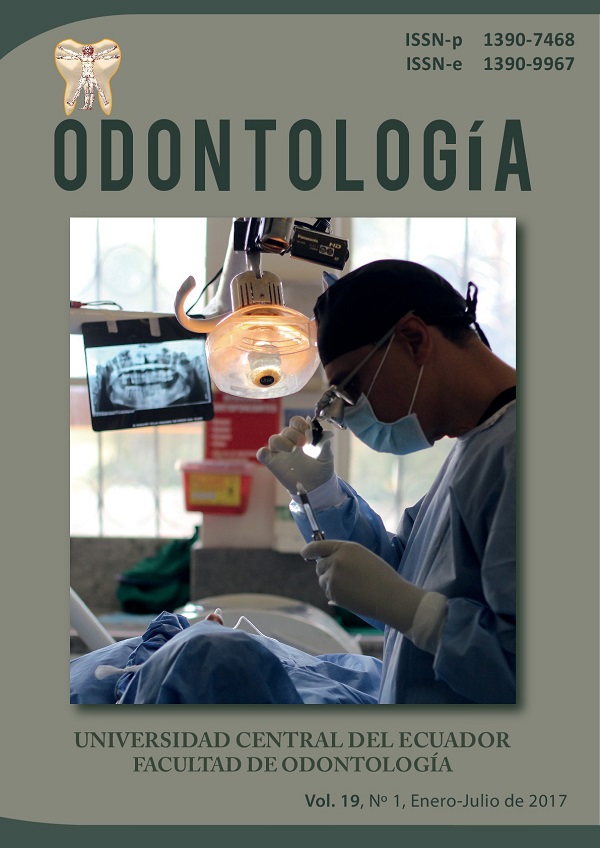Evaluación radiográfica del grado y radio de curvatura en conductos mesio vestibulares de primeros molares superiores
Palabras clave:
Endodoncia, anatomía interna, curvatura radicularResumen
Objetivo: Determinar el grado y radio de curvatura y su asociación de los conductos radiculares de las raíces mesiales de molares superiores humanos de población Ecuatoriana. Materiales y métodos: Se examinaron un total de 50 primeros molares superiores humanos extraídos, obtenidos del banco de dientes del Subcentro de salud de Tumbaco Pichincha Ecuador, los criterios de exclusión fueron dientes previamente endodonciados, con presencia de caries, reabsorciones o fracturas radiculares. Se tomaron radiografías periapicales con técnica de paralelismo, el grado de curvatura se midió en sentido mesio distal con el método de Schneider 1971, y se obtuvo el radio de las curvaturas con la técnica descrita por Estrela 2008. Los datos obtenidos se analizaron mediante la prueba U de Mann Whitney con nivel de significancia del 5%. Resultados: Se determinó que el ángulo de la curvatura fue 10%, 58% y 32% para bajo, moderado y severo respectivamente, mientras que el radio de la curvatura fue 64%, 34%, y 2% para leve, moderado y severo respectivamente. Existió una diferencia estadísticamente significativa entre el ángulo moderado y radio leve de los grupos estudiados (p=0,02) Conclusión: Se determinó que es más frecuente el ángulo de curvatura moderado y radio leve.
Descargas
Citas
Sadeghi S, Poryousef V. A novel approach in assessment of root canal curvature. Iranian Endodontic Journal 2009; 4(4): 131-134.
Abesi F, Ehsani M. Radiographic evaluation of maxillary anterior teeth canal curvatures in an Iranian population. Iranian Endodontic Journal 2011; 6(1): 25-28.
Willershausen B, Kasaj A, Röhrig B, Briseño Marroquin B. Radiographic Investigation of Frequency and Location of Root Canal Curvatures in Human Mandibular Anterior Incisors In Vitro. Journal of Endodontic 2008; 34: 152–156.
Estrela C, Bueno M, Sousa Neto M, Djalma J. Method for Determination of Root Curvature Radius Using Cone-Beam Computed Tomography Images. Braz Dent J 2008; 19(2): 114-118.
Tikku A, Pragya W, Shukla I. Intricate internal anatomy of teet and its clinical significance in endodontics - A review. Endodontology; 2005: 160-169.
Pecora J. Morphologic study of the maxillary molars part: external anatomy. Braz Dent J 1991; 2(1):45-50.
Zheng Q, Zhou X, Jiang Y, Sun T, Liu CH, Xue H, Huang D. Radiographic Investigation of Frequency and Degree of Canal Curvatures in Chinese Mandibular Permanent Incisors. Journal of Endodontic 2009; 35:175–178.
Schäfer E, Diez C, Hoppe W, Tepel J. Roentgenographic Investigation of Frequency and Degree of Canal Curvatures in Human Permanent Teeth. Journal of Endodontics 2002; 28(3): 211-216.
Zhu X. Evaluation of the reliability of Schneider´s and Weine´s method. Int Chin J Dent 2003; 3: 118-121.
Pruett J, Clement D, Carnes D. Cyclic fatigue testing of nickel-titanium endodontic instruments. Journal of Endodontic 1997; 23(1):77– 85.
Seidberg A. Frequency of two mesiobuccal root canals in maxillary permanent first molars. J Am Dent Assoc. 1973; 87(1):852-856.
Ki Lee J, Hyun Ha B, Ho Choi J, Heo S, Perinpanayagam H. Quantitative Three-Dimensional Analysis of Root Canal Curvature in Maxillary First Molars Using Micro-Computed Tomography. Journal of Endodontic 2006; 32: 941–945.
Günday M, Sazak H, Garip Y. A Comparative Study of Three Different Root Canal Curvature Measurement Techniques and Measuring the Canal Access Angle in Curved Canals. Journal of Endodontic 2005; 31(11):796-798.
Park P, Kim K, Perinpanayagam H, Ki Lee J, Woo Chang S, Hye Chung S, Kaufman B, Zhu Q, Safavi K, Yeon Kum Y. Three-dimensional Analysis of Root Canal Curvature and Direction of Maxillary Lateral Incisors by Using Cone-beam Computed Tomography. Journal of Endodontic 2013; 39: 1124–1129.
Willershausen B, Tekyatan H, Kasaj A, Briseño B. Roentgenographic In Vitro Investigation of Frequency and Location of Curvatures in Human Maxillary Premolars. Journal of Endodontic 2006; 32: 307–311.
Gu Y, Lu Q, Wang P, Ni L. Root Canal Morphology of Permanent Three-rooted Mandibular First Molars: Part II—Measurement of Root Canal Curvatures. Journal of Endodontic 2010; 36: 1341–1346.
Pecora. J. Internal Anatomy, Direction, and number of Roots and Size of Human Mandibular Canines. Braz Dent J 1993; 4(1): 53-57.
Campos P, Cabral C, Vasconcelos C, Lima A, Gomes M. Study of the Internal Morphology of the Mesiobuccal Root of Upper First Permanent Molar Using Cone Beam Computed Tomography. Int. J. Morphol.2011; 29(2): 617-621.
Venskutonis T, Plotino G, Juodzbalys G, Mickevicien L. The Importance of Conebeam Computed Tomography in the Management of Endodontic Problems: A Review of the Literature. JOE 2014; 40: 1895-1901
Gerhard T, Paque F, Zeller M, Willershausen B, Briseno B. Root Canal Morphology and Configuration of 118 Mandibular First Molars by Means of Micro–Computed Tomography: An Ex Vivo Study. JOE 2016: 1-5


